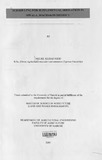Scheduling for supplemental irrigation in Mwala, Machakos district
Abstract
This study focuses on supplemental irrigation in Mwala area of Machakos District. 1 he area is classified as Arid and Semi-Arid land (ASAL) where rainfall is unreliable in both time and space. This has often led to crop failure that results to famine in the area.
Rainfall analysis was done to determine onset, cessation, length of the rainy season and occurrence of in-season drought spells. Early onset resulted to more seasons’ rainfall. During the short rains, early onset dates of 4thOctober in the years 1984, 1994 and 1997 gave an average rainfall amount of 822mm while late onset dates of 8lh November 1981, 18"' November 1983 and 3,d November 1991 gave an average rainfall amount of 248. Early onset also resulted to more wet days as opposed to late onset. The short rains season was found to be more reliable for maize growing being more and better distributed over the growing season. The average amount for the short rains was 506 mm spread over 70 days for the short rains and 421 mm spread over 60 days for the long rains during the 19 years analyzed.
The in-season dry spells were found to occur in most seasons. Severity of the dry spells increased as the crop-growing season progressed. Dry spells occurring early in the growing season were an indication of a shortened rainy season. Examples are the long rains of 1983, 1984, 1987, 1992 and 1993. Dry spells occurring during flowering were considered hazardous as they resulted into high yield reduction and hence the need to store water for supplemental irrigation. There was a general shift of weather as the length of the rainy season got more with advance in years during the short rains.
The amount of water required for supplemental irrigation for all the seasons was carried out. Results showed uniformity in the amount of water required during the long rains but much variation during the short rains. The average amount required for the short rains was 152.8mm with a standard deviation of 77.3 while the average amount was 124.7 for the long rains with a standard deviation of 44.7. However better distribution of rainfall during the short rains is an indication supplemental irrigation could give better yields during the short rainy seasons.
Supplemental irrigation schedule to supply water to the crops during dry spells was carried out for the short rains of 1997. This was achieved through determining the moisture holding capacity of the soil, the actual crop evapotranspiration. the crop's root depth, and the level of allowable moisture depiction.
Publisher
University of Nairobi

